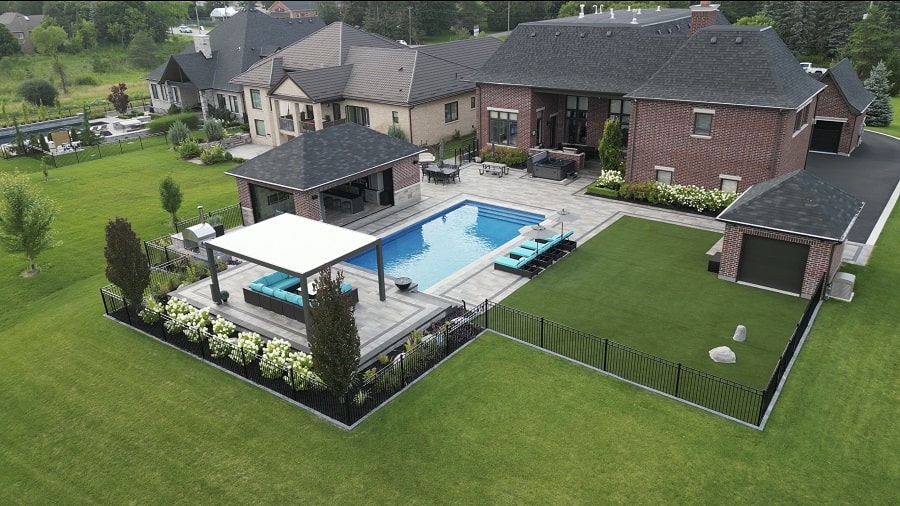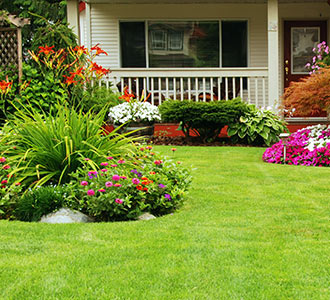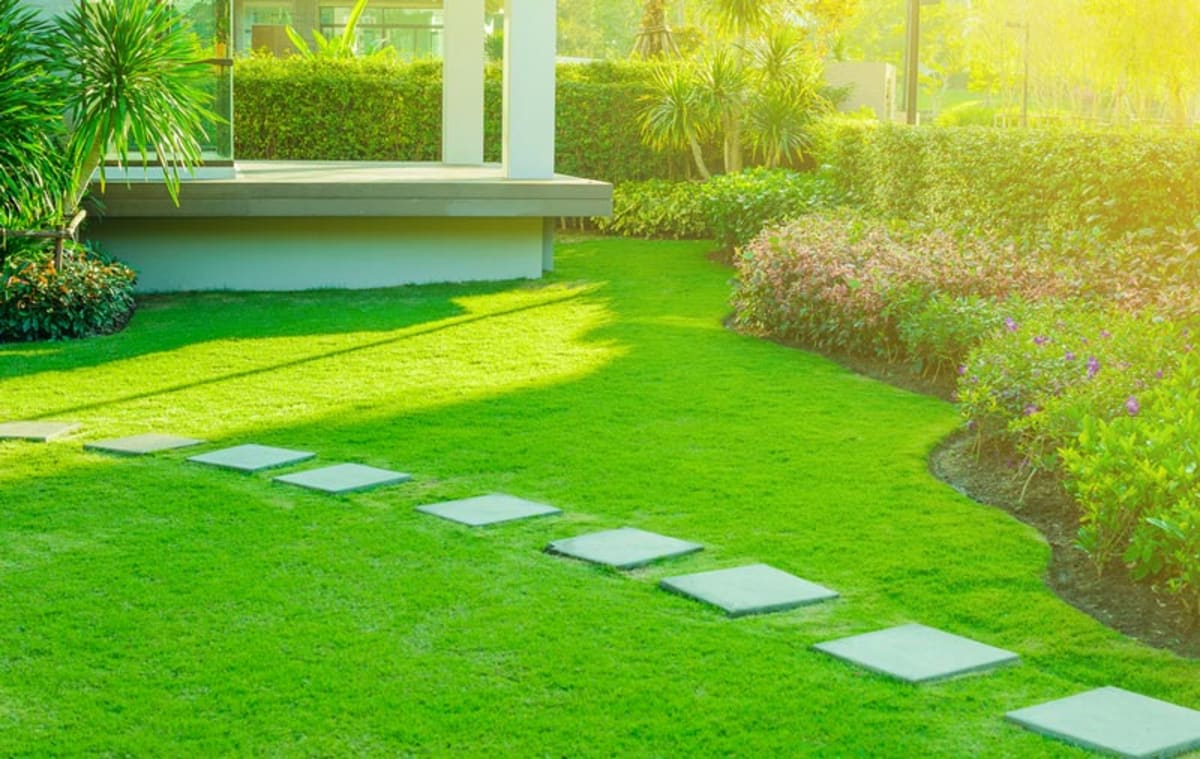Understanding the Comprehensive Extent of Works in Expert Landscape Design Services
The extensive range of specialist landscaping services incorporates a variety of fundamental components - landscaping services. It consists of landscape design principles, plant selection, and hardscaping functions. In addition, it resolves watering systems and upkeep techniques. Each element plays a critical role in developing practical and cosmetically pleasing outside spaces. Recognizing just how these elements interact can reveal much concerning the art and scientific research of landscape design. Nevertheless, the journey into this intricate field is simply beginning
Landscape Design Principles
Efficient landscape style principles are important for creating harmonious exterior areas that enhance both visual allure and performance (Learn More). These principles assist the setup of aspects within the landscape, making certain a natural aesthetic experience. Trick components consist of equilibrium, which distributes visual weight uniformly; percentage, which associates the dimension of numerous aspects to each other and the room; and unity, which develops a feeling of integrity via regular motifs and materials

Plant Choice and Installment
In the domain of specialist landscape design, plant option and setup play a vital function in achieving a flourishing yard. Emphasizing indigenous plant benefits, seasonal factors to consider, and the particular soil and sunlight demands of each species assures a sustainable and cosmetically pleasing landscape. Careful preparation in these locations not only enhances biodiversity however likewise promotes long-term environmental wellness.
Native Plant Advantages
Why should property owners consider native plants for their landscaping projects? Indigenous plants supply various benefits that improve both appearances and environmental sustainability. They are well-adapted to local climates, needing less water and upkeep compared to non-native varieties. This durability minimizes the requirement for chemical plant foods and chemicals, advertising a healthier environment. Additionally, native plants supply habitat and food for regional wild animals, including pollinators, which can boost biodiversity in houses. Their knowledge with local soil and weather condition problems also results in better development rates and longevity. By picking native plants, homeowners not only create visually appealing landscapes yet additionally add to eco-friendly preservation, making a positive influence on their neighborhood setting. Subsequently, native plants stand for a wise choice for landscape design projects.
Seasonal Plant Considerations
House owners that have actually accepted native plants in their landscape design can even more improve their outside rooms by considering seasonal plant options. By integrating plants that grow in particular periods, they can produce visually enticing and vibrant landscapes throughout the year. Springtime may introduce dynamic blossoms like tulips and daffodils, while summertime can showcase rich foliage and colorful perennials. Fall presents a combination of warm tones with goldenrods and asters, while winter season can be highlighted with evergreens and ornamental lawns for structure. Specialist landscapers typically suggest selecting plants that not only enhance existing native types however additionally offer year-round rate of interest and support regional wild animals. This thoughtful strategy to seasonal plant option guarantees a continuously advancing and sustainable garden setting.
Soil and Sunlight Needs
Successful landscaping depends upon recognizing the specific dirt and sunshine requirements of plants. Various species grow under varying problems, requiring a mindful assessment of both elements during the selection process. Soil kinds, such as sandy, clay, or loamy, impact drain, vitamins and mineral availability, and origin development. Additionally, pH levels can influence plant health and wellness, necessitating soil testing to determine suitability. Sunshine demands vary significantly; some plants prosper completely sunlight, while others choose partial or full color. An expert landscaper thinks about these elements to ensure peak development and aesthetic appeal. By straightening plant options with the environment's specific characteristics, landscapes can achieve sustainability, resilience, and aesthetic consistency, inevitably bring about successful plant establishment and lasting upkeep.
Hardscaping Attributes and Construction

While landscape design commonly stimulates photos of rich greenery and vivid blossoms, hardscaping functions play a vital duty in defining outside rooms. These elements, that include patio areas, sidewalks, retaining walls, and attractive stonework, provide structure and performance to lawns and gardens. Hardscaping utilizes products such as concrete, timber, block, and stone, permitting diverse layouts that enhance the all-natural landscape.
The building of hardscaping attributes needs mindful preparation and execution to ensure toughness and visual charm. Specialists analyze site conditions, water drainage, and spatial partnerships to produce natural exterior environments. Proper setup strategies are essential, as they avoid problems like disintegration and shifting in time.
Including hardscaping not just enhances the visual rate of interest of a property however also facilitates exterior activities, making it a basic element of complete landscape design services. Inevitably, thoughtful hardscaping adds to both the functionality and appeal of outside rooms.
Irrigation Systems and Water Administration
Effective irrigation systems and water monitoring are vital components of expert landscaping, as they assure that plants obtain the needed hydration for suitable development. These systems can differ from straightforward drip irrigation configurations to advanced automated automatic sprinkler, made to meet the certain demands of diverse landscapes. Appropriate water monitoring not just optimizes water usage, decreasing waste, but likewise boosts plant health and lessens illness dangers.
Landscape design specialists assess various factors, including soil kind, plant species, and neighborhood climate, to develop customized watering remedies. Additionally, integrating rain harvesting strategies can even more improve sustainability and effectiveness. Routine upkeep of watering systems is important to preserve performance and avoid leaks, which can bring about water loss and raised costs (Learn More). Ultimately, a properly designed watering system plays a critical duty in protecting the aesthetic appeal of outdoor areas while promoting ecological stewardship within expert landscaping techniques
Yard Care and Maintenance Techniques
Lawn treatment and maintenance strategies are essential for attaining a lavish, healthy and balanced yard that improves the overall landscape. These methods encompass numerous techniques intended at promoting excellent development and aesthetic allure. Normal mowing is vital, as it encourages thick, even growth while preventing weeds from developing. Furthermore, appropriate fertilization supplies essential nutrients, with applications customized to the specific turf kind and dirt conditions.
Watering practices should concentrate on deep, irregular watering to urge root growth, while oygenation boosts dirt framework and advertises vitamins and mineral absorption. Pest and condition monitoring is additionally essential; determining problems early enables for effective treatments that decrease damages.
Overseeding can renew damaged or slim yards, boosting thickness and color (landscaping). By executing these targeted lawn treatment techniques, landscaping professionals can guarantee that backyards remain healthy and balanced and lively throughout the seasons, substantially contributing to the overall elegance of the residential property
Seasonal Landscape Treatment and Upkeep
As the seasons adjustment, proper landscape treatment comes to be crucial for preserving the health and charm of outside rooms. Each season offers distinct difficulties and demands. In spring, landscape specialists concentrate on trimming, growing, and fertilizing to motivate growth. Summer season demands normal watering, weed control, and insect management to shield freshly developed plants.

Throughout the year, seasonal landscape maintenance guarantees that exterior areas remain visually attractive and healthy. Professional services can supply tailored maintenance plans that adapt to the details requirements of each period, allowing homeowner to enjoy dynamic landscapes year-round. In general, seasonal treatment is an important aspect of specialist landscaping that advertises long life and aesthetic value.

Sustainable Landscape Design Practices
An expanding variety of building proprietors are embracing sustainable landscape design techniques to create ecologically pleasant exterior areas. These techniques concentrate on saving sources, boosting biodiversity, and decreasing ecological influence. Indigenous plants are usually chosen for their low water needs and compatibility with local ecological communities, minimizing the need for chemical fertilizers and pesticides. Rain yards and absorptive paving are used to handle stormwater overflow, advertising groundwater recharge and reducing disintegration.
Lasting landscaping integrates organic gardening methods that prioritize dirt health and promote natural parasite control. Efficient watering systems, such as drip irrigation read more and rain harvesting, help enhance water use. In addition, landscape designers significantly advocate for the use of recycled materials, such as redeemed wood and stones, to reduce waste. By adopting these sustainable techniques, residential or commercial property owners not only contribute to environmental conservation but likewise produce visually pleasing atmospheres that can love minimal upkeep.
Regularly Asked Inquiries
How Lengthy Does a Landscaping Task Generally Require To Complete?
Typically, a landscape design task can take anywhere from a couple of days to a number of weeks to complete, depending on the project's style, dimension, and intricacy needs. Variables such as weather and resource schedule additionally affect timelines.
What Factors Impact the Expense of Landscape Design Services?
Numerous variables affect landscaping solution costs, including task size, style intricacy, worldly high quality, labor expenses, geographic area, and seasonal need. Each aspect adds distinctly to the total financial needs of a landscaping task.
Are Landscape Design Services Available Year-Round?
Landscape design services are typically available year-round, although accessibility may differ based on area, seasonal weather condition problems, and particular service offerings. Some services might be restricted throughout extreme climate or off-peak periods.
Do Landscape Design Business Offer Warranties on Their Work?
Lots of landscape design business do provide service warranties on their job, which can differ in length and insurance coverage. Customers are encouraged to inquire concerning particular terms, guaranteeing they recognize what is guaranteed and any kind of conditions that apply.
Can I Layout My Landscape Without Professional Help?
Yes, people can create their landscapes without specialist assistance. They may do not have competence in plant option, format, and environmental factors to consider, potentially leading to much less efficient layouts that could call for pricey adjustments later.
In the domain of expert landscape design, plant selection and installment play an important role in attaining a thriving yard. Property owners that have welcomed native plants in their landscaping can better boost their exterior spaces by thinking about seasonal plant choices. Effective landscaping hinges on recognizing the details soil and sunshine demands of plants. Reliable irrigation systems and water administration are vital elements of specialist landscape design, as they ensure that plants receive the necessary hydration for perfect development. Landscaping professionals evaluate different variables, including dirt type, plant species, and local environment, to develop tailored irrigation services.